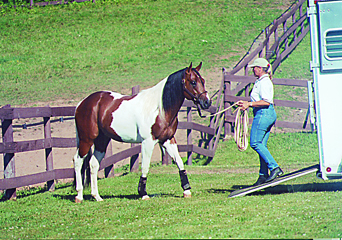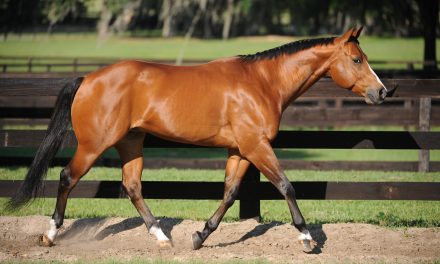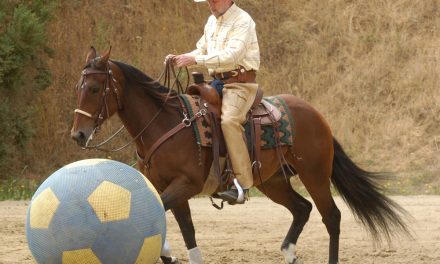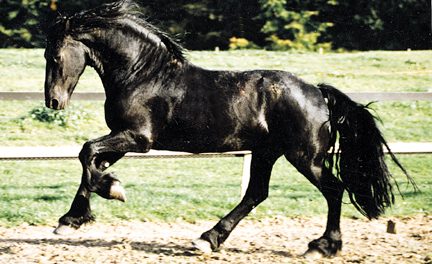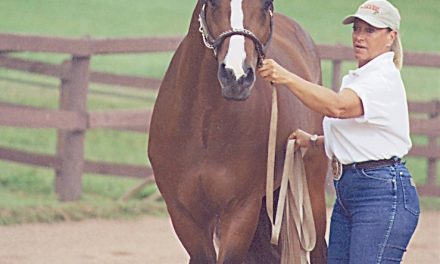Palm Partnership Training™
Building a Partnership with Your Horse
 There is nothing more frustrating than having trouble loading your horse in a trailer. The way to avoid this is to take the time in the first place to properly teach your horse to load and unload properly. We want each trailer loading experience to be a positive one for the horse. A trailer loading experience that frightens or confuses him will only make the next loading session more difficult to achieve.
There is nothing more frustrating than having trouble loading your horse in a trailer. The way to avoid this is to take the time in the first place to properly teach your horse to load and unload properly. We want each trailer loading experience to be a positive one for the horse. A trailer loading experience that frightens or confuses him will only make the next loading session more difficult to achieve.
Trailer loading is an important lesson that builds on the basic training commands we taught the horse in earlier lessons. These include “come to me”, “move away from me”, “whoa”, and “back”. If his understanding is not solid on these maneuvers, go back and re-teach them before moving on to the trailer loading lesson.
Give you and your horse a training advantage by taking these steps to properly prepare for this lesson.
Park the trailer you will be using in enclosed paddock or small field when introducing this lesson. This will give you and your horse a more secure environment to work in. I prefer using a trailer with a ramp because it is a little easier for the horse, but the same procedures will work just fine for a “step up” trailer.
Back the trailer up so it is close to and alongside a fence. The creates a “barrier” on one side of the trailer that will help keep your horse’s attention and concentration focused on the trailer. Keep the trailer hooked to the tow vehicle, if possible. This will make the trailer more stable. Be sure to set the vehicle’s brakes for extra safety and stability.
Open all of the trailer’s rear doors, walk through front doors, windows, etc. to allow the maximum amount of light to enter the trailer. If the trailer is a “walk through” with a chest bar, make sure the bar is unhooked or down. Horses fear going into dark, confined areas—like a closed up trailer! Try to make the inside of the trailer look as much like the outdoors as possible.
Put some good things to eat in the trailer like a hay bag full of hay or oats in the feed tray. I always keep a full hay bag in my trailer. One of my friends calls this “trailer bait”. It is a tasty incentive for the horse to enter the trailer, a reward when he does, and gives him his favorite thing to do (eat) once he’s inside.
Have all of the tools you need to teach this lesson on hand. They include a longe whip, an in-hand whip, a lead line, and a longe line that has a snap on one end and a loop handle on the other end. Your horse should be equipped with a properly fitting halter, with the lead line attached, and leg protection for this lesson.
Your Next Step…
The key to success is being consistent in the procedures we use each time we ask the horse to load into the trailer. Here’s an overview of proper steps for safe loading:
- Let the horse “address the trailer”. This means allowing him to sniff and investigate it before asking him to load.
- Position the horse at the end of the ramp (or edge of a step up trailer) keeping his body and head straight.
- Stand part way up the ramp, or near the back edge of a step up trailer, facing your horse. Give the “come to me” command to get him to come toward you. Never pull on the lead to force him into the trailer. This only teaches him to lean against the lead. Be patient with this step.
- As he moves up the ramp (or steps up into the trailer), back up so that you are entering the trailer in front of him. Being in this position allows you to see his reaction and keep his body straight.
- Once the horse follows you into the trailer, run the lead rope through the hay bag, but do not tie him up, yet. Fasten the chest bar. As he concentrates on eating his hay, step out of the trailer. Walk around to back the trailer to prepare for fastening the butt bar. For safety, always stand off to one side of the trailer in case your horse would kick or move backward. Pet and reassure him as you fasten the butt bar.
- Return to the horse’s head and tie his lead so he can stand comfortably without any tension on his head or the lead. There should be just a little slack in the lead when it is tied so he can’t get his head down too far and get into trouble. I like to tie my horses with a quick release safety knot with the lead passed through it. At this point you are ready to close the trailer’s doors and ramp for departure!
Lynn’s Training Tip…
Take the next step and to learn how to teach your horse how to safely load and unload with my Longevity Series Video #2- “Advanced Ground Training”. In this video I demonstrate the step-by-step methods to use to introduce trailer loading to a young horse plus important safety tips. The 90-minute video is packed full of other important training techniques to teach your horse the ground training basics including bathing, clipping, and progressing to ground commands in less secure areas. Set a foundation for success with your horse from the ground up. Visit my website www.lynnpalm.com, click on “On-Line Store” for more details on my Palm Partnership Training products to help you and your horse train at home to build a better partnership together!

